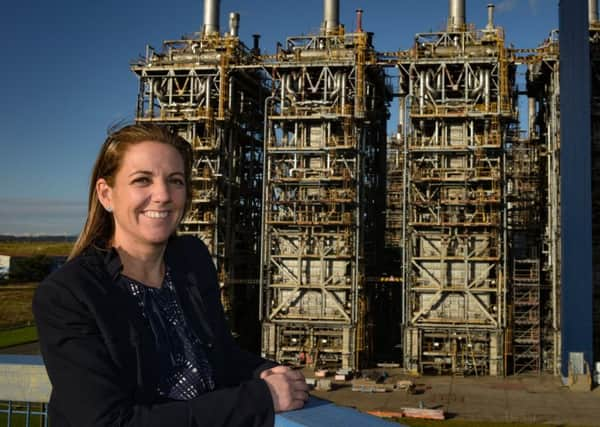Mossmorran tells locals '˜We're listening', after flaring issues


Mossmorran has had its fair share of critics in the last year, and plant manager Sonia Bingham knows that better than most.
That’s why she’s keen to be more open about what goes on at Fife Ethylene Plant, and communicate with local people better.
Advertisement
Hide AdAdvertisement
Hide Ad“We’ve always prided ourselves on being a good neighbour and a member of the community here,” said adds.
“Following on from the flaring we had in the last couple of years, we’ve been getting feedback from people locally about their concerns.
“We’ve also been asking them what we could do better and how to improve things. They’ve given us input into the actions that we needed to take.
One of the resounding messages we got from the community was regarding our communications – most importantly when we do have an unplanned incident.
Advertisement
Hide AdAdvertisement
Hide AdSo one thing we’ve tried to improve on is our base communication, but also when there is an unplanned incident that we get our communications out, increase in frequency, and also in a language that people can readily understand.
The new Twitter account is just part of that new drive to keep people up to date withwhat’s going on.
As the Press was given a tour round the plant recently, we spoke to staff and managers about the concerns many local people have.
With a number of well-publicised periods of flaring at the plant, it’s worth knowing not only what happens, but why it happens.
Advertisement
Hide AdAdvertisement
Hide AdIn a nutshell, natural gas goes into the plant, and plastic is sent out. A number of other chemicals are separated and put to use elsewhere or used commercially. Almost nothing is wasted.
The wispy white fog we see leaving the air is nothing more than steam from the heating processes that take place – “My daughter thinks I work in a cloud factory,” one employee tells us during the tour.
When something goes wrong the plant needs to burn off excess gas and halt production – that’s when we see the controversial flaring take place.
Sadly, it happened a few times too many lately for many people living in the area, with frustration growing among locals.
Advertisement
Hide AdAdvertisement
Hide AdBut believe it or not, no one wants it to end more than the plant’s owners Exxon Mobil.
When the flaring ends, it means the problem is fixed and the plant can resume production – something that makes things far more comfortable for staff.
Sonia says no one feels the need to end flaring more than those at the plant.
“As many of our team live in the local area it’s very much in all of our interests.
Advertisement
Hide AdAdvertisement
Hide Ad“It’s part of our production so having the flaring reduced or ceased is when we’re back up and running so it’s definitely in our best interests for business reasons too.
“As a good business we want to maximise our production day-in day-out.
“We understand the concerns, we don’t want to cause any disturbance, because our people live in the communities here and so do their families.”
Relating to those communities is something Mossmoran is definitely looking to improve upon.
Advertisement
Hide AdAdvertisement
Hide AdThe plant had previously been accused of either keeping the public in the dark, or making explanations about the difficulties too technical – but no more.
Sonia adds: “I think in the past our communication was quite high-level and lacked detail.
“So we really try to make sure that we make it relevant and understandable to the people who might not be actively involved in what we do.
“We’re totally committed to minimising our flaring, particularly unplanned flaring.
Advertisement
Hide AdAdvertisement
Hide Ad“We know the concern and the disturbance that it causes so we want to reduce it, but obviously if it does occur then we want to make sure that we give that reassurance to the community that we’re doing everything we can, and also the outlook of when they can expect it to be fixed.”
Aways from the more publicised problems, the plant is also busy helping assorted local causes.
“We get involved in a lot of external activities and are involved in various groups. We have an internal team that looks to set these things up. One thing we have currently is supporting the foodbanks.
“We have lots of donations and people bringing things in and looking to support local familes.”
Advertisement
Hide AdAdvertisement
Hide AdDonations are split between Kirkcaldy and Dunfermline foodbanks, with a number of other initiatives throughout the year.
“The plant here has an extremely strong record in both safety and performance. It’s a world-class facility with a very solid future.
“For the future, it’s looking very good.”
What goes on at the plant?
Gas which originates in the North Sea, ends up being sold at the end of the chain as plastics and various gas fuels.
The main feed coming into Mossmorran is Ethane, this is part of natural gas from the North Sea.
Advertisement
Hide AdAdvertisement
Hide AdIt is sent down via pipeline from St Fergus in Aberdeenshire.
The ethane is heated up in furnaces. Here it reacts to produce a liquid - ethylene.
The ethylene is then sent by pipeline down to Braefoot Bay between Dalgety Bay and Aberdour, and then put out on to ships, and then made into polyethylene, a solid plastic, at other locations.
The site is highly integrated. Many byproducts are recycled or reused as an energy source. Any leftover gas is burnt as fuel.Excess steam also helps the plant keep going. Mossmorran uses the steam to generate power, making the plant almost self-sufficient.